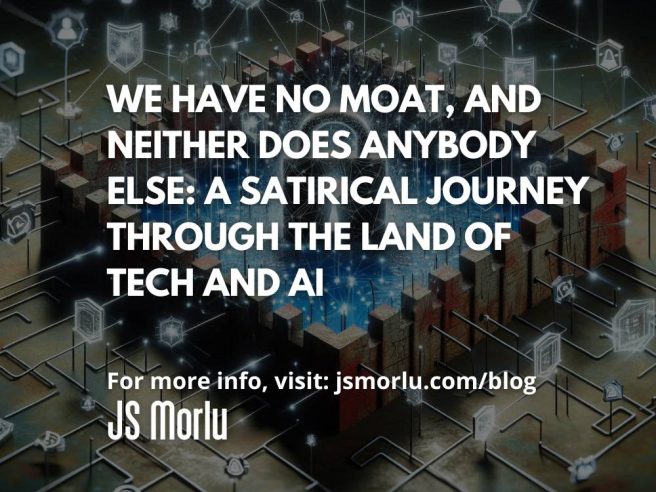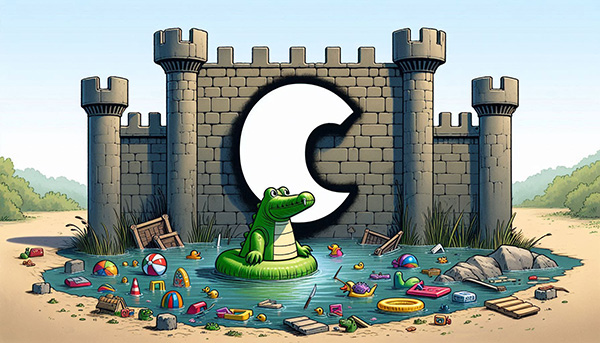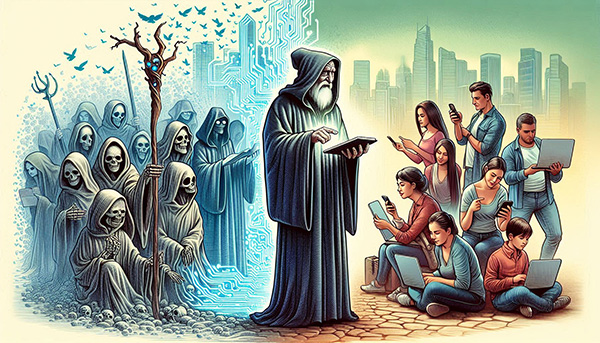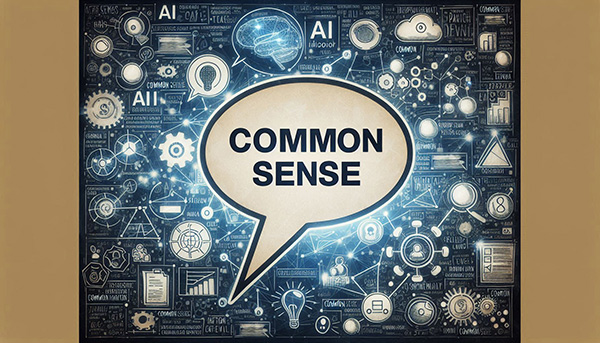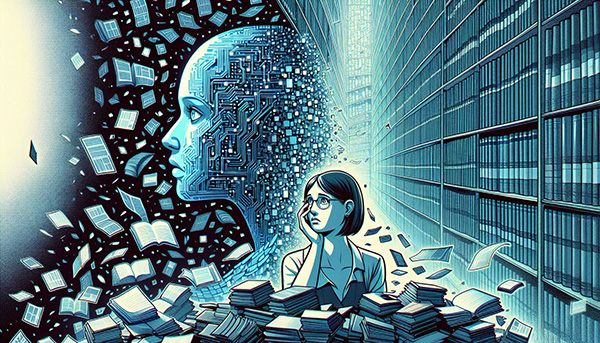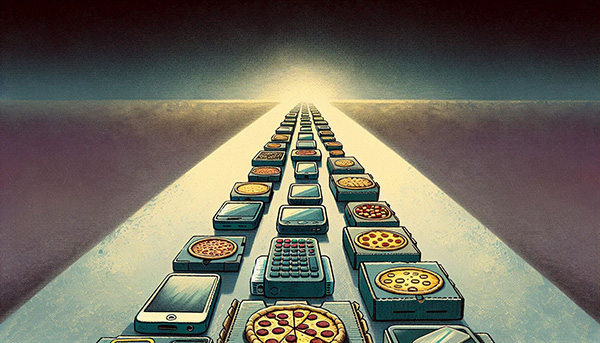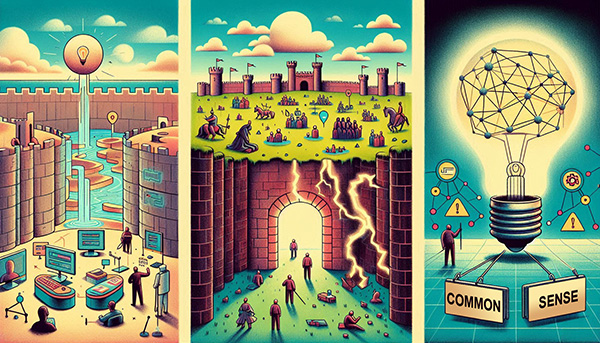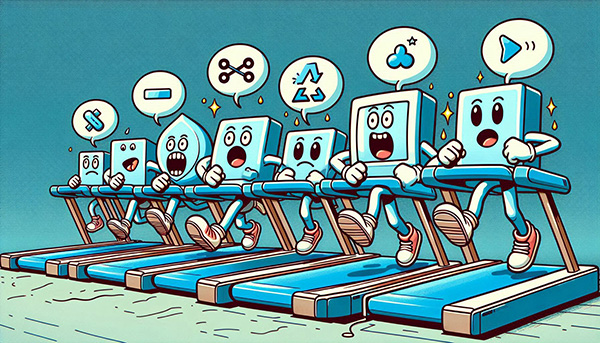By: John S. Morlu II, CPA
In the heart of Silicon Valley—a mythical land where innovation is worshipped and fortunes are made faster than a Wi-Fi signal—a quiet revelation slipped through the cracks. It didn’t involve some groundbreaking algorithm or a new code that could outpace a programmer running on three espressos. No, this revelation was something far more disruptive, more humbling. A leaked memo, now famously titled “We Have No Moat, and Neither Does Anybody Else,” exposed a simple but profound truth: the seemingly invincible titans of tech were, in fact, no different from the rest. The moat they believed protected their empires of data and artificial intelligence was nothing more than a mirage.
This was a wake-up call for an industry obsessed with speed, innovation, and the next big thing. It was a reminder that no matter how sophisticated the technology or how exclusive the data, everyone was playing the same game—on a level playing field. It wasn’t just about AI or corporate competition; it was a revelation that threatened the very foundation of how tech companies understood their advantage. The emperor, it seemed, wasn’t just underdressed—he had no clothes at all.
But this is not just a story of technological nudity or corporate embarrassment. It’s a tale of insight, ego, and the quiet triumph of common sense over corporate grandeur. It’s a reminder that sometimes, the real advantage lies not in secret codes or proprietary systems but in a clear-eyed understanding of reality. So, grab your overpriced, artisanal latte and settle in for a thoughtful exploration of the tech world’s fascinating descent into a moatless future, where even the sharpest minds can stumble over their own inflated sense of invulnerability.
Chapter 1: The Moat That Wasn’t
Ah, the moat. In medieval times, a moat was a deep, broad ditch filled with water that protected castles from invaders. In today’s business speak, it’s a company’s competitive advantage—its invisible barrier keeping competitors at bay. Google thought they had one: a deep, sparkling, AI-filled moat. But then they looked closer and realized… it was more like a kiddie pool, complete with floaties.
Here’s the kicker: it wasn’t just Google. In a plot twist worthy of a Netflix series, it turned out that nobody had a real moat. The AI memo that leaked from Google was the tech equivalent of finding out that everyone at the party is just as bad at karaoke as you.
The memo explained that AI models were being commoditized—like everyone making artisanal donuts. It didn’t matter if you were the biggest bakery (Google) or a mom-and-pop shop (a scrappy startup); as long as you had the same flour (data), you’d get a pretty similar donut. Data, once a closely guarded treasure, had become as accessible as a password-sharing Netflix account. And just like that, Google’s magic moat? Poof. Gone.
Turns out, nobody was the wizard behind the curtain. The moat wasn’t a moat; it was more like a kiddie pool—and a crowded one at that. Welcome to the new normal, where everyone’s playing the same AI game, and it’s about as exclusive as an all-you-can-eat buffet.
Chapter 2: The Great Algorithm Bake-Off
Picture this: Gordon Ramsay, furious as ever, standing in front of a bunch of tech giants—Google, Microsoft, OpenAI, and an ambitious Estonian startup, “SomethingAI.” He’s hosting the world’s first-ever AI bake-off, where the challenge is to whip up the most mind-blowing algorithm.
“Right, you muppets!” Ramsay bellows. “You’ve got one hour to create the greatest AI of all time. Let’s see some bloody genius!”
The contestants rush to their stations, armed with the same ingredients: data. Heaps and heaps of it. Google’s team is furiously stirring their algorithmic pot, OpenAI’s whipping up a shiny new GPT-4, and SomethingAI’s looking smug with their AI chef who has a PhD in machine-whisking.
But here’s the twist: all the dishes taste exactly the same.
Ramsay takes a bite, unimpressed. “They’re all… fine. But where’s the magic? You lot are like kids making pasta out of Play-Doh!”
The truth? When everyone’s using the same ingredients, there’s no standout. Google’s AI, OpenAI’s chatbot, Microsoft’s learning model—it’s all spaghetti, just with different sauces. They’ve all mastered the recipe, but no one has the secret sauce.
Chapter 3: When Everyone’s a Wizard, No One Is
There was a time when being a tech wizard was like being a Hogwarts graduate—special, exclusive, maybe even magical. But fast-forward to today, and it feels like everyone’s a wizard. If AI used to be an arcane art, it’s now an open-source e-book you can download for free.
Take ChatGPT. It used to wow us with its human-like responses. Now, it’s as predictable as a rom-com plotline: you know what it’s going to say before it even finishes. If you handed the same tools to a group of caffeinated college students with access to a cloud server, they could whip up something pretty close.
The moat of “we’re smarter than you” vanished. Engineers weren’t pulling late-night magic sessions in secret labs anymore. Instead, they were tinkering with data, throwing in some algorithms, and crossing their fingers. It was like pulling a rabbit out of a hat but forgetting to feed the rabbit first—sure, it still worked, but the magic was gone.
Chapter 4: Common Sense Enters the Chat
Now, someone at the back of the room might be raising their hand, asking, “Isn’t this just common sense?” Yes! Yes, it is. In the grand circus of AI, we’ve been ooh-ing and ahh-ing over some pretty basic tricks.
AI, for all its fancy jargon—deep learning, neural networks, hyperparameters—boils down to pattern matching. Feed it enough data, and it’ll mimic intelligence, but don’t mistake that for true brilliance. It’s like teaching a parrot to say, “Polly wants a cracker.” Sure, it can talk, but Polly’s not about to pen a bestselling novel.
So, while Silicon Valley likes to parade around their “disruptive” AI, the reality is we’re all parrots in a very high-tech cage. The AI mimics us, and we mimic it, until we all just blend into one big feedback loop of tech jargon and pizza orders.
Chapter 5: The Emperor’s New Chatbot
This is where we all collectively groan. The AI race? Not really a race. It’s more like a slow shuffle where everyone crosses the finish line at the same time and pretends they’re winning.
Google, OpenAI, Meta—they’re all on the same treadmill, cranking out algorithms that look suspiciously similar. They’re shouting about “breakthroughs” while quietly realizing that the moat they once flaunted is little more than a glorified puddle.
Startups once believed they could break into this race, armed with nothing but clever ideas and optimism. But soon, they too realize that it’s not about being clever—it’s about who has the most data. And so, we shuffle along, all running the same AI marathon on the same track, hoping no one notices how similar our results look.
Chapter 6: Lessons in Absurdity
So, what can we learn from this wild ride through the world of AI? Here are the absurd but important lessons:
1. Data is King, and We’re All Playing Court Jester: Whoever controls the most data rules the kingdom. AI engineers aren’t the wizards we thought—they’re more like really efficient librarians sorting through endless shelves of books.
2. The Moat is a Mirage: The tech giants’ prized moat? Gone. As long as everyone has access to the same public data and algorithms, the outcomes are eerily similar. It’s like a cookie-baking contest where everyone’s using the same recipe.
3. Common Sense is the True Innovation: Amid all the fancy AI algorithms, the real innovation is good old-fashioned common sense. Maybe the next big thing won’t come from complex models, but from a simple, human-centered approach.
Chapter 7: A Peek Into the AI Renaissance
Let’s zoom out for a moment and look at the bigger picture. The AI renaissance? Not so much an explosion of groundbreaking innovation as it is a bunch of smart people tweaking their algorithms by 0.5% and calling it revolutionary.
Think of it like a car race where everyone’s driving the same model. Instead of trying to build a flying car, these competitors are fine-tuning their engines, adjusting their mirrors, and claiming they’ve “reinvented” the vehicle. Spoiler: they haven’t.
This is what passes for innovation in the AI world today. It’s more “let’s make this slightly better” than “let’s create something completely new.” And the best part? They’ll still slap a shiny new label on it and declare, “Welcome to the future!”
Chapter 8: The Unseen Cost of the Moatless World
All jokes aside, there’s a darker side to this story. While the AI memo pokes fun at the idea of a “moat,” it highlights a real problem. In a world where AI tools are easily accessible, we might start seeing a race to the bottom.
Startups and mid-sized companies, scrambling to keep up with the big players, might cut corners. Innovation becomes less about creating something new and more about keeping up. And in the end, who loses? Us—the consumers—who are stuck using AI that’s “good enough” but not groundbreaking.
It’s like ordering pizza and getting the same basic pepperoni every time. Sure, it’s good, but where’s the innovation? Where’s the magic?
Chapter 9: Lessons from a Moatless Future
As we wrap up this strange journey through the moatless land of AI, a few vital truths stand tall, casting long shadows over the tech giants and scrappy startups alike. These lessons don’t just point to the state of AI today; they offer a guidebook for what’s coming next—because the future doesn’t belong to those who hoard technology behind high walls, but to those who adapt and innovate with open hands.
1. Data is Everywhere: The Great Leveler
In the world of AI, data is the new oil, but it’s not locked beneath the Earth’s crust—it’s spilling over into every corner of the digital world. The magic of AI doesn’t come from proprietary algorithms or hidden formulas anymore; it comes from sheer access to vast amounts of information. Whether you’re a tech behemoth or a small garage startup, data is your currency. And guess what? Everyone has some.
The democratization of data means that it’s no longer about who can build the most sophisticated model; it’s about who can leverage what’s already out there, who can wield this resource with the sharpest mind, and, critically, who can do so responsibly. The future isn’t locked behind the gates of a few elite companies—it’s in the hands of anyone who can creatively use this abundant resource to build something new, useful, and ethical.
2. Moats Are for Castles, Not Tech Companies
The idea of a moat, once the ultimate symbol of security and competitive advantage, is a relic of the past in the tech world. Today, that moat is a myth. In the AI arena, no company has exclusive rights to genius. The secret sauce everyone talks about? Turns out it’s just ketchup in a fancy bottle.
The tech landscape is more like an open field now. Everyone is armed with the same tools, working with the same data. If you’re hoping to create a fortress around your AI model and keep the competition out, think again. The walls are down. What matters now is agility—the ability to learn, adapt, and pivot faster than your competitors. Moats might still work for castles, but in tech? Speed, creativity, and execution are the new defenses.
3. Common Sense is Priceless
In a world teeming with algorithms, neural networks, and machine learning buzzwords, sometimes the most profound solution is the simplest. We’ve been dazzled by AI’s capacity to generate endless reams of text, images, and data predictions, but maybe the real breakthrough is not in making machines smarter—it’s in using AI to enhance what we already know: common sense.
In the arms race to create the “best” AI, we might have lost sight of the fact that not everything needs to be automated or overly complex. The future of AI may not come from outsmarting human intelligence but from complementing it. Sometimes the answer isn’t to build a more sophisticated machine—it’s to build a tool that makes our human decisions a little clearer, a little more efficient, and a lot more impactful. The genius isn’t in the complexity; it’s in clarity and purpose.
Chapter 10: Baking a Better Future
And so, with these lessons in hand, we wave goodbye to the dream of magical moats and elite wizards, and instead, we welcome a future defined by pragmatism, creativity, and collaboration. The myth of exclusivity in AI has been shattered, and in its place, we find a more democratic world—one where success is measured not by how complex or secretive your technology is, but by how well you can use it to solve real problems.
It turns out, sometimes the smartest thing isn’t to reinvent the wheel—or the algorithm. It’s to recognize when all you really need to do is bake a better cookie. But unlike the exclusive bake-offs of the past, this time the recipe is out in the open for everyone. The question is: What are you going to do with it?
The moatless future doesn’t spell doom for innovation—it promises an era where innovation is more accessible, diverse, and impactful than ever before. The race isn’t over—it’s just beginning, and in this new world, there’s room for everyone to take part.
Because when everyone’s playing in the same field, the real magic isn’t in guarding the prize—it’s in baking something that leaves the world hungry for more.
Author: John S. Morlu II, CPA is the CEO and Chief Strategist of JS Morlu, leads a globally recognized public accounting and management consultancy firm. Under his visionary leadership, JS Morlu has become a pioneer in developing cutting-edge technologies across B2B, B2C, P2P, and B2G verticals. The firm’s groundbreaking innovations include AI-powered reconciliation software (ReckSoft.com) and advanced cloud accounting solutions (FinovatePro.com), setting new industry standards for efficiency, accuracy, and technological excellence.
JS Morlu LLC is a top-tier accounting firm based in Woodbridge, Virginia, with a team of highly experienced and qualified CPAs and business advisors. We are dedicated to providing comprehensive accounting, tax, and business advisory services to clients throughout the Washington, D.C. Metro Area and the surrounding regions. With over a decade of experience, we have cultivated a deep understanding of our clients’ needs and aspirations. We recognize that our clients seek more than just value-added accounting services; they seek a trusted partner who can guide them towards achieving their business goals and personal financial well-being.
Talk to us || What our clients says about us

